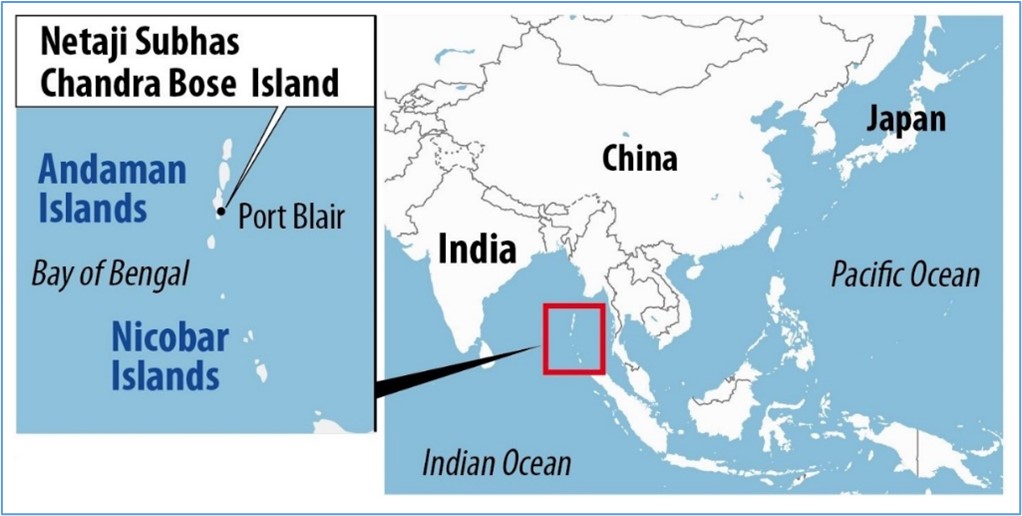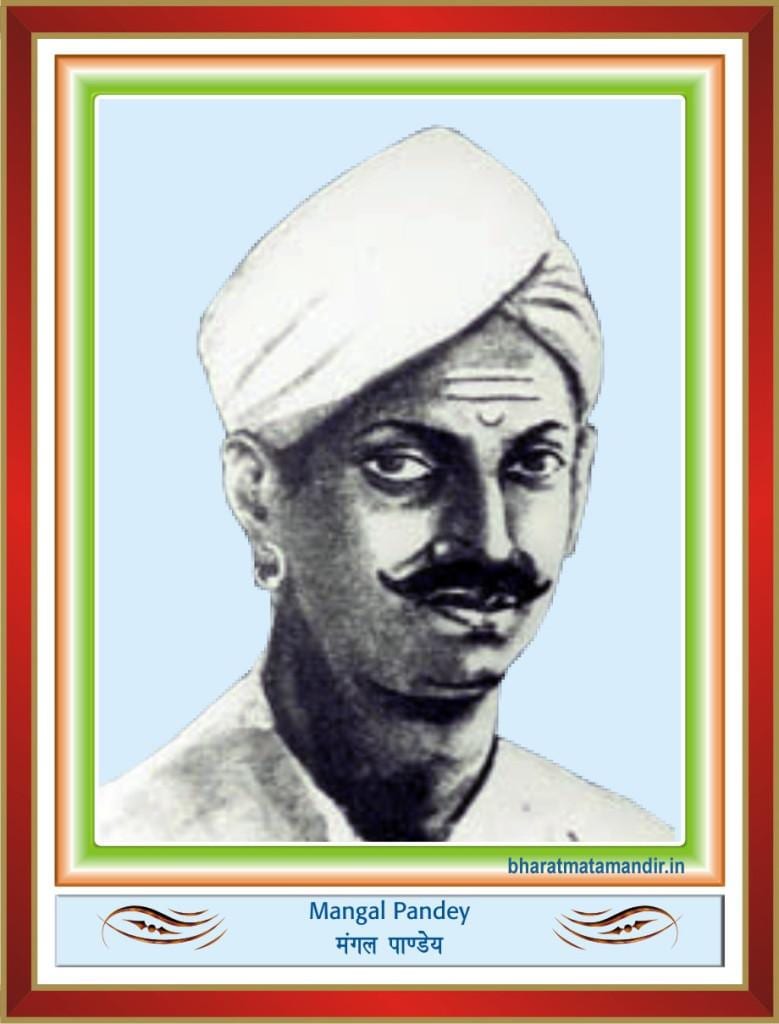Netaji Subhash Chandra Bose Island
Why in News: The uncontrolled increase in the population of Chital deer is causing issues on Netaji Subhash Chandra Bose Island.
Table of Contents
ToggleAbout Netaji Subhash Chandra Bose Island
Island Location and Renaming:
- Formerly known as Ross Island, now officially designated as Netaji Subhash Chandra Bose Island.
- Situated three kilometers east of Central Port Blair in the Andaman Islands.
- Part of the South Andaman administrative district within the Andaman and Nicobar Islands.
Strategic Importance and History:
- The Andaman and Nicobar Islands hold a strategic position in the Indian Ocean, lying between the Indian mainland, Myanmar, and Indonesia, and near crucial maritime routes.
- Initially governed by the Dutch and later by the British, the islands fell under Japanese control during World War II.
- The Azad Hind government gained de jure control from the Japanese by late 1943, with Subhash Chandra Bose arriving in Port Blair on December 29.
Renaming in Tribute:
- In recognition of the islands’ historical significance and to honor Netaji Subhas Chandra Bose, Ross Island was renamed as Netaji Subhash Chandra Bose Island during the Prime Minister’s 2018 visit.
- Additionally, Neil Island was renamed Shaheed Dweep and Havelock Island as Swaraj Dweep.
Tourist Attractions:
- All three islands—Netaji Subhash Chandra Bose Island, Neil Island (Shaheed Dweep), and Havelock Island (Swaraj Dweep)—are prominent tourist destinations.
Source: IE
Satpula Dam
Why in News: The ancient Satpula dam, constructed in the 14th century and the oldest one in Delhi, remains sturdy to this day.
About Satpula Dam
Construction and Name Origin:
- Satpula, meaning ‘seven bridges,’ was built during the reign of Sultan Muhammad Shah Tughlaq (1325-1351).
- The dam’s name reflects its structure, with ‘sat’ referring to seven and ‘pula’ indicating openings of a bridge.
Building Material and Purpose:
- Constructed using Delhi quartz, a stone sourced from the Aravalli region.
- Integral to the defensive wall of Jahanpanah, the fourth city of Delhi.
Dual Functionality:
- The dam served two primary functions: providing a consistent water source for irrigation and fortifying against potential intruders.
Design and Development:
- Developed by identifying suitable topography, particularly a vast open plain ideal for water storage and irrigation of expansive flatlands.
- Equipped with sluice gates and a reservoir, the structure facilitated water management.
Cultural Significance:
- Located near the residence of Sufi saint Nasiruddin Mahmud, also known as Chirag Dehlavi, leading to beliefs about the canal water possessing healing properties.
- The area traditionally hosted a Diwali mela (fair) for centuries, where attendees would partake in a holy dip in the waters and often collect some to take home.
Source: IE
Mangal Pandey
Why in News: Mangal Pandey, a key figure in the Sepoy Mutiny of 1857, is commemorated annually on April 8, the anniversary of his death.
About Mangal Pandey
Role in the Rebellion:
- Mangal Pandey played a pivotal role in India’s initial uprising against British dominance in 1857, often referred to as the First War of Independence or the Sepoy Mutiny.
Early Life:
- Born near Faizabad in Uttar Pradesh on July 19, 1827.
- In 1849, Pandey enlisted in the army of the British East India Company and served as a sepoy in the 6th Company of the 34th Bengal Native Infantry stationed in Barrackpore.
Resistance against the East India Company:
- Pandey rebelled against the British East India Company’s decision to introduce cartridges greased with animal fat, which was offensive to the religious beliefs of the sepoys.
- His act of defiance sparked a broader movement that spread across India, inciting a mass revolt against colonial rule. Civilians also joined the uprising, protesting against oppressive colonial laws.
Execution and Legacy:
- On March 29, 1857, Pandey mutinied by firing at his Senior Sergeant Major.
- He was subsequently captured, tried by a Court Martial, and hanged on April 8, 1857, at Lal Bagan in Barrackpore.
- Following his execution, his regiment, like the 19th infantry at Behrampore, faced dissolution due to their display of discontent.
Source: IE
U.N. Membership Process
Why in News: The United Nations Security Council has directed the Palestinian application for full membership in the UN to a committee for further consideration.
About UN Security Council
Eligibility for UN Membership:
- UN full membership is available to all peace-loving states that agree to uphold the obligations outlined in the United Nations Charter and demonstrate their ability to fulfill these obligations.
Admission Procedure:
- States gain membership in the United Nations following a decision made by the General Assembly upon the recommendation of the Security Council.
Application Process:
- A state wishing to join submits an application to the Secretary-General along with a formal letter acknowledging its acceptance of the Charter obligations.
- The Security Council reviews the application.
Security Council Recommendation:
- For an admission recommendation to be valid, it must receive affirmative votes from at least nine of the Council’s 15 members, provided none of the five permanent members (P5) cast a negative vote.
- The P5 members include China, France, the Russian Federation, the United Kingdom of Great Britain and Northern Ireland, and the United States of America.
General Assembly Consideration:
- If the Security Council recommends admission, the proposal is then presented to the General Assembly for deliberation.
- A two-thirds majority vote in the Assembly is required for the admission of a new state.
Effective Membership:
- Membership becomes official on the date when the Assembly adopts the resolution for admission.
Note on Government Changes:
- Changes in government, such as through democratic elections, do not raise any concerns regarding the credentials of the state’s representative.
Source: TH
Glycaemic Index
Why in News: Research from an international study indicates that adhering to diets with low glycaemic index and low glycaemic load may help in preventing the onset of type 2 diabetes.
About Glycaemic Index
Blood Sugar Response:
- Carbohydrate-containing foods are ranked based on their post-meal blood glucose response.
- Higher blood sugar readings correspond to higher Glycaemic Index (GI) values.
Impact on Blood Sugar:
- GI indicates how rapidly a food affects blood sugar levels when consumed individually.
- Foods are rated on a scale of 0 to 100, with pure glucose having a GI of 100.
Influence of Processing and Composition:
- Lower GI foods lead to a slower increase in blood sugar levels post-consumption.
- Generally, processed foods have higher GI values, while foods rich in fiber or fat tend to have lower GI values.
Explaining Glycaemic Load:
Glycaemic load (GL) considers both the quality and quantity of carbohydrates in a particular food.
It is calculated by multiplying the GI of a food by the amount of available carbohydrates in a serving.
Insight into Diabetes:
Chronic Condition:
- Diabetes is a chronic ailment resulting from the inability of the pancreas to produce sufficient insulin or the body’s ineffectiveness in utilizing the produced insulin.
Role of Insulin:
- Insulin, a hormone, regulates blood glucose levels in the body.
- Inadequate insulin production or utilization leads to elevated blood glucose levels, termed hyperglycaemia.
Long-term Effects:
- Prolonged high glucose levels are linked to bodily damage and dysfunction of various organs and tissues.
Types of Diabetes:
Type 1 Diabetes:
- An autoimmune condition where the immune system targets and destroys insulin-producing beta cells in the pancreas.
- Individuals with type 1 diabetes typically produce little to no insulin and require daily insulin administration.
- Formerly known as juvenile diabetes, it often manifests in children and young adults.
Type 2 Diabetes:
- Arises from the body’s ineffective utilization of the insulin it produces.
- Primarily associated with excess body weight and physical inactivity.
Source: TH






